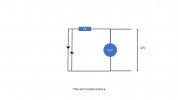electricity_bill
Registered
Hello
Been playing with an old double ended OO scale diesel loco and fitting it with directional LED lighting. They work well and shine brightly but the problem is that when running forward, the back, light flickers and visa versa. They are 3V 10mA LEDs fed from the 12V track supply via the loco with a 1K resistor to reduce the volts. Any ideas how to stop it?
Bill
Been playing with an old double ended OO scale diesel loco and fitting it with directional LED lighting. They work well and shine brightly but the problem is that when running forward, the back, light flickers and visa versa. They are 3V 10mA LEDs fed from the 12V track supply via the loco with a 1K resistor to reduce the volts. Any ideas how to stop it?
Bill
Last edited:

